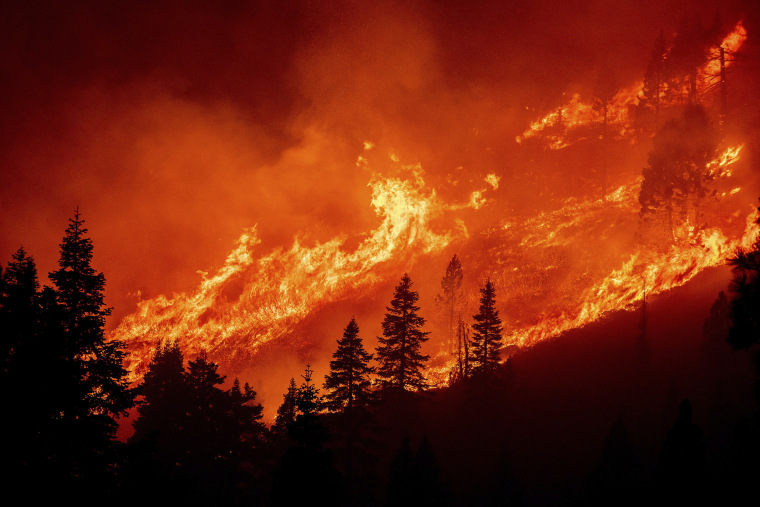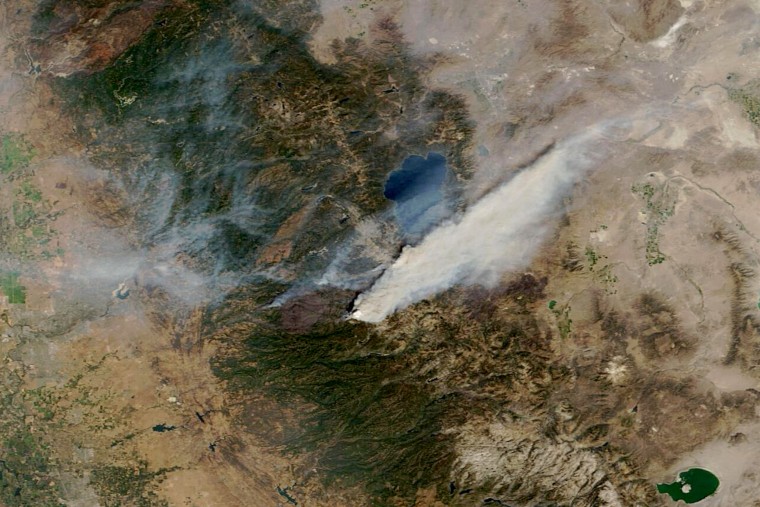SOUTH LAKE TAHOE, Calif. — Firefighters are attempting to steer the aggressive Caldor Fire in Northern California toward the neighboring Tamarack Fire, a "fresh burn area" that could provide an important and natural stopping point for the fast-moving inferno, fire officials said Tuesday during a community meeting.
"Sometimes when the fire is burning extreme that's all we can do," said Eric Schwab, an operations section chief with the California Department of Forestry and Fire Protection, or Cal Fire. "It's a fresh burn, and if we get it steered into there ... that basically stops the spread of fire. It's a very valid tactic that we're trying to do."
The Tamarack Fire, which was sparked by lightning on July 4, spans nearly 70,000 acres across Alpine County in California and Douglas County in Nevada. It was 82 percent contained as of Tuesday.
Residents in parts of Douglas County, Nevada, were under evacuation orders Tuesday evening as the Caldor Fire continued its destructive march east. They were instructed to turn off sprinkler systems before leaving their homes amid worsening drought conditions across the West.
"Conserving water NOW will help ensure water supply is available if needed," county officials tweeted.
The Caldor Fire has already scorched more than 191,000 acres as of Tuesday and is 16 percent contained. At least three firefighters and two civilians have been injured since the blaze started nearly three weeks ago.
Earlier Tuesday, the ferocious wildfire continued its rampage toward a popular vacation destination just hours after roads were clogged with fleeing cars when the entire California resort city of South Lake Tahoe was ordered to evacuate and communities just across the state line in Nevada were warned to get ready to leave.
About 700 structures have been destroyed and more than 30,000 remain threatened. Law enforcement officials are working closely with fire crews and the California and Nevada national guards to oversee evacuation efforts and keep a close eye on property.
More than 15,000 firefighters were battling dozens of California blazes, including crews from Utah, Washington, Wisconsin and West Virginia, said Mark Ghilarducci, director of the California Governor’s Office of Emergency Services. About 250 active-duty soldiers were being trained in Washington state to help with the arduous work of clearing forest debris by hand.
Crews from Louisiana, however, had to return to that state because of Hurricane Ida, “another major catastrophic event taking place in the country and is a pull on resources throughout the United States,” he said.
"We are using all of our resources, everything that we have at our disposal," Nevada Gov. Steve Sisolak said Tuesday.
He and California Gov. Gavin Newsom declared states of emergencies Monday in advance of the fire's persistent march toward Lake Tahoe. Newsom, who is facing a recall, signed a separate order allowing out-of-county firefighters and other emergency workers to cast their ballots for the Sept. 14 election.
"We thank all the heroic firefighters and first responders working around the clock to combat this rapidly spreading fire and to protect local communities across California this fire season," Newsom said in a statement.
Lake Tahoe, a popular vacation haven normally filled with tens of thousands of summer tourists, emptied out Monday as the massive Caldor Fire rapidly expanded. Vehicles loaded with bikes and camping gear and hauling boats were in gridlocked traffic, stalled in hazy, brown air that smelled like a campfire. Police and other emergency vehicles whizzed by.
“It's more out of control than I thought,” evacuee Glen Naasz said of the fire that by late Monday had been pushed by strong winds across California highways 50 and 89, burning mountain cabins as it swept down slopes into the Tahoe Basin.

Ken Breslin was stuck in bumper-to-bumper traffic less than a mile from his home in the city of 22,000, with only a quarter-tank of gas in his Ford Escape. His son begged him to leave Sunday night, but he shrugged him off, certain that if an evacuation order came, it would be later in the week.
“Before, it was, ‘No worries ... it’s not going to crest. It’s not gonna come down the hill. There’s 3,500 firefighters, all those bulldozers and all the air support,’” he said. “Until this morning, I didn’t think there was a chance it could come into this area. Now, it’s very real.”
Monday’s fresh evacuation orders, unheard of in the city, came a day after communities several miles south of the lake were abruptly ordered to leave as the fire raged nearby. South Lake Tahoe’s main medical facility, Barton Memorial Hospital, proactively evacuated dozens of patients, and the El Dorado Sheriff’s Office transferred inmates to a neighboring jail.
“There is fire activity happening in California that we have never seen before. The critical thing for the public to know is evacuate early,” said Chief Thom Porter, director of the California Department of Forestry and Fire Protection, or Cal Fire. “For the rest of you in California: Every acre can and will burn someday in this state.”

The threat of fire is so widespread that the U.S. Forest Service announced Monday that all national forests in California would be closed until Sept. 17.
Porter said that only twice in California history have blazes burned from one side of the Sierra Nevada to the other, both this month, with the Caldor and Dixie fires. The Dixie, the second-largest wildfire in state history at 1,205 square miles about 65 miles north of the Lake Tahoe-area blaze, prompted new evacuation orders and warnings Monday.
